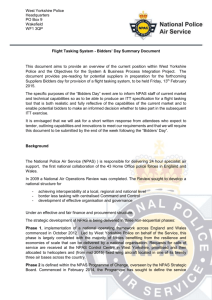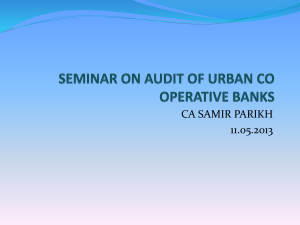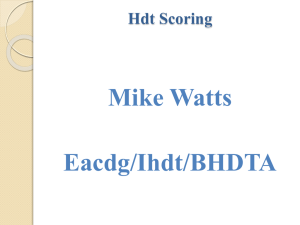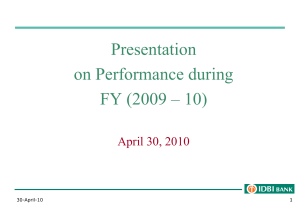segmenting_self_pay_..
advertisement
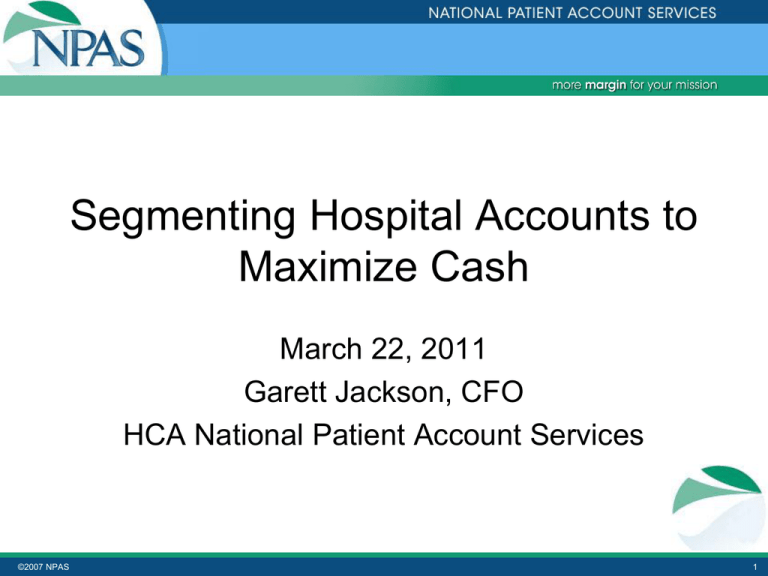
Segmenting Hospital Accounts to Maximize Cash March 22, 2011 Garett Jackson, CFO HCA National Patient Account Services ©2007 NPAS 1 Learning Objectives • Understanding the Self Pay Portfolio • How predictive models were incorporated into the process • What variables are within the data already obtained from the patient? • Future state of modeling and segmentation • Translating data into results ©2007 NPAS 2 Understanding the Self Pay Portfolio Benchmark – Evaluate – Segment - Measure ©2007 NPAS 3 Front-End: Copay Responsibility Shift Insurance plans are paying less of the overall bill. Hospitals are left to get the remaining portion from the patient. Gains upfront are not offsetting the increase in responsibility ©2007 NPAS 4 Front-End Efforts – Self Pay More of the original balance was discounted. Front-end collections from the patient are decreasing at the same time. ©2007 NPAS 5 Economic Conditions Have Changed Average Credit Score by Placement Month 700 600 500 400 300 200 200801 200802 200803 200804 200805 200806 200807 200808 200809 200810 200811 200812 200901 200902 200903 200904 200905 Private Pay - CoPay and Deductible ©2007 NPAS Private Pay - Pure Self Pay 6 Last Fifteen Months Monthly Average Credit Scores 700 650 600 550 500 450 400 350 Copay Avg Score ©2007 NPAS 201012 201011 201010 201009 201008 201007 201006 201005 201004 201003 201002 201001 200912 200911 200910 200909 300 Self Pay Avg Score 7 Negotiation: What to Expect 82% of SP calls don’t commit to pay ©2007 NPAS 8 Collections Life Cycle Front End Collections Back Office (Early Out) Collection Agency Pre-admit payments Payment from letters Payment from credit reporting Payment at registration Payment from contacts Payment at discharge Payment from re-billing Payment from billing Customer Service Focus Identified as Facility Bad Debt Payment from legal actions Payment from aggressive collection activity Identified as collection agency Mission Based Collection Practices NPAS Statistics ©2007 NPAS 9 HCA’s Bad Debt Action Plan • HCA started implementing its Bad Debt Action Plan in an effort to understand and attack the issue quickly. Early out was a key focus of the plan: – What does the healthcare portfolio look like compared to other industries? – Is it possible to change the early-out collection strategy to address the portfolio? – Which resources (up-front, early-out, primary) are best equipped to handle the inventory? – Which key indicators have the largest impact on collections? ©2007 NPAS 10 Credit Scoring Notes • • • • • • Used the Equifax ERS 3.0 scoring method, which ranges from 1 to 1000 Grouped number of accounts in scored index ranges of 100 Scores of 0 mean that no data was available Scoring vendor provided six industry comparisons done by Equifax Compared results against All Industries, Auto Finance, and Bankcard Industries Work Effort is defined as Attempts, Contacts and Letters ©2007 NPAS • • • • Self Pay was analyzed for comparative purposes. However, the study compares Copay and Deductible in general. Scoring vendor provided scores for approximately 241k accounts with a 96% score rate Used a random sample of closed accounts Statistical accuracy of sample is 95% +/- 4% as a valid representation of our inventory 11 Early Out Inventory Credit Scoring Index Ranges by Industry Compared to Recovery Rate at NPAS 70% 60% 90% 80% 77.31% 70% 50% 40% 50% 44.09% 40% 30% 27.93% Recovery Percent Percent of Total Accounts 60% 30% 20% 20% 17.65% 12.67% 10% 11.02% 7.69% 6.44% 6.92% 5.07% 0% 0% 901-High 801-900 NPAS (Hospital) Industry ©2007 NPAS 10% 701-800 601-700 Average of All Industries 501-600 401-500 301-400 Average of Auto Finance 201-300 Bankcard Industry 101-200 000-100 NPAS Recovery Rate 12 Upfront Collection Efforts HCA Upfront Collections by Scoring Range Percent Recovered Upfront 6.00% 5.0% 5.00% 4.00% 3.0% 3.00% 2.00% 1.8% 2.0% 1.0% 1.00% 0.7% 0.6% 0.6% 0.5% 0.6% 0.7% 00 100 10 0 0 N on -S co re d 10 120 0 20 130 0 30 140 0 40 150 0 50 160 0 60 170 0 70 180 0 90 1H ig h 80 190 0 0.00% Pct Recovered Upfront ©2007 NPAS 13 Copay/Deduct – Group Mix Comparison of Net Placements and Recovery Credit Scoring Index Ranges by Region Compared to Recovery Rate at NPAS 45% 40% 30% IndexRange 000-100 101-200 201-300 301-400 401-500 501-600 601-700 701-800 801-900 901-High Grand Total 90% 80% 70% 60% 25% 50% 20% 40% 15% 30% 10% 20% 5% 10% 0% 0% 000-100 ©2007 NPAS Recovery Rate Percent of Accounts in Score Range 35% 100% REGION 01 REGION 05 REGION 07 Percent of Net Recovery Percent of Net Recovery Percent of Net Recovery Placements Rate % Placements Rate % Placements Rate % 17.5% 29% 24.7% 22% 19.2% 19% 4.3% 22% 6.2% 9% 8.2% 5% 5.9% 21% 7.1% 12% 9.0% 15% 4.8% 17% 7.4% 12% 6.2% 21% 6.5% 38% 6.0% 12% 6.6% 24% 3.9% 38% 5.7% 26% 5.6% 22% 3.0% 45% 6.0% 26% 7.1% 51% 5.0% 63% 5.1% 31% 5.2% 42% 6.8% 63% 7.8% 40% 7.8% 59% 42.3% 82% 24.2% 69% 25.1% 89% 100.0% 55% 100.0% 33% 100.0% 42% 101-200 201-300 301-400 401-500 501-600 601-700 701-800 801-900 901-High REGION 01 - Percent of Net Placements REGION 05 - Percent of Net Placements REGION 07 - Percent of Net Placements REGION 01 - Sum of Recovery Rate REGION 05 - Sum of Recovery Rate REGION 07 - Sum of Recovery Rate 14 Self Pay Credit Scoring Index Ranges by Industry Compared to Recovery Rate at NPAS 70% 60% 60% 48.58% 50% 50% 40% 30% 30% Recovery Percent Percent of Total Accounts 40% 21.80% 20% 20% 12.22% 10% 10% 6.56% 4.48% 4.04% 2.15% 2.24% 2.03% 3.07% 0% 0% 901-High 801-900 NPAS (Hospital) Industry ©2007 NPAS 701-800 601-700 Average of All Industries 501-600 401-500 301-400 Average of Auto Finance 201-300 Bankcard Industry 101-200 000-100 NPAS Recovery Rate 15 Self Pay - Emergency Room Credit Scoring Index Ranges by Industry Compared to Recovery Rate at NPAS 70% 60% 52.76% 60% 50% 50% 40% 31.79% 30% 30% Recovery Percent Percent of Total Accounts 40% 20% 20% 14.41% 10% 8.74% 10% 6.27% 4.44% 2.78% 2.79% 2.79% 3.24% 0% 0% 901-High 801-900 NPAS (Hospital) Industry ©2007 NPAS 701-800 601-700 Average of All Industries 501-600 401-500 301-400 Average of Auto Finance 201-300 Bankcard Industry 101-200 000-100 NPAS Recovery Rate 16 Self Pay - Inpatient Credit Scoring Index Ranges by Industry Compared to Recovery Rate at NPAS 70% 40% 36.39% 35% 60% 30% 25% 40% 20% 30% 15% 11.63% 20% 8.95% 10% 10% 5% 3.28% 2.08% 2.10% 2.76% 0.45% 1.09% 0.74% 0% 0% 901-High 801-900 NPAS (Hospital) Industry ©2007 NPAS Recovery Percent Percent of Total Accounts 50% 701-800 601-700 Average of All Industries 501-600 401-500 301-400 Average of Auto Finance 201-300 Bankcard Industry 101-200 000-100 NPAS Recovery Rate 17 Self Pay – Outpatient Credit Scoring Index Ranges by Industry Compared to Recovery Rate at NPAS 70% 80% 68.54% 70% 60% 60% 50% 40% 40% 30% 30% 29.17% 21.12% 20% 20% 18.94% 10% 7.42% 9.19% 5.88% 6.95% 4.16% 10% 3.22% 0% 0% 901-High 801-900 NPAS (Hospital) Industry ©2007 NPAS Recovery Percent Percent of Total Accounts 50% 701-800 601-700 Average of All Industries 501-600 401-500 301-400 Average of Auto Finance 201-300 Bankcard Industry 101-200 000-100 NPAS Recovery Rate 18 Self Pay - Surgery Credit Scoring Index Ranges by Industry Compared to Recovery Rate at NPAS 70% 60% 52.85% 60% 50% 50% 40% 30% 26.24% 30% Recovery Percent Percent of Total Accounts 40% 21.83% 20% 20% 14.31% 12.76% 8.86% 10% 10% 5.46% 3.42% 3.87% 2.70% 0% 0% 901-High 801-900 NPAS (Hospital) Industry ©2007 NPAS 701-800 601-700 Average of All Industries 501-600 401-500 301-400 Average of Auto Finance 201-300 Bankcard Industry 101-200 000-100 NPAS Recovery Rate 19 Incorporating Predictive Results ©2007 NPAS 20 Self Pay – Work Effort Average Work Effort Versus Recovery Rate by Index Ranges 6.1 5.7 5.6 5.6 48.6% 5.3 5.1 5.0 5.0 5.0 401-500 Avg Workeffort ©2007 NPAS 301-400 201-300 101-200 3.1% 501-600 2.0% 601-700 2.2% 701-800 2.1% 801-900 4.0% 901-High 4.5% 6.6% 12.2% 21.8% 4.7 000-100 Recovery Rate % 21 Credit Scoring Flow (Self Pay) FC 99 Day 1 Score account Day 2, receive credit score Category = Low ? No Current Flow Yes Letter 1 Hold 20 days Final Notice Letter Wait 30 days To Agency Note: No match, match no score and typos will follow current flow Phase II - No match may go into low ©2007 NPAS 22 Copay and Deductible Credit Scoring Index Ranges by Industry Compared to Recovery Rate at NPAS 70% 90% 83.72% 80% 60% 70% 50% Percent of Total Accounts 40% 50% 47.25% 40% 30% 36.58% Recovery Percent 60% 58.98% 30% 27.61% 20% 25.15% 22.32% 21.57% 20% 17.88% 13.22% 10% 10% 0% 0% 901-High 801-900 NPAS (Hospital) Industry ©2007 NPAS 701-800 601-700 Average of All Industries 501-600 401-500 301-400 Average of Auto Finance 201-300 Bankcard Industry 101-200 000-100 NPAS Recovery Rate 23 Credit Scoring Flow (Copay and Deductible) Non FC99 Day 1 SP Letter Wait 30 days Contact with Patient or payment received? No Score Accounts Day 31 Category = Low ? No Current Flow Yes Yes Current Flow Notes: No match, match no score and typos will follow current flow Phase II - No match may go into low ©2007 NPAS Final Notice Letter Wait 30 days To Agency 24 Results: The Reason for Scoring 2010 Recovery vs Work Effort 70.00% 8.00 62.7% 7.00 7.4 60.00% 50.9% 40.00% 6.00 6.3 50.00% 4.9 5.00 5.4 5.1 4.5 4.5 4.4 4.00 27.2% 30.00% 3.00 20.00% 2.00 11.8% 10.00% 3.3% 1.5% 1.0% 1.5% 401-500 301-400 201-300 0.00% .00 901-999 801-900 701-800 601-700 Avg Work Effort ©2007 NPAS 1.00 501-600 Recovery Rate 25 Results: Credit Scoring Segmentation Copay and Deductible -Low Score <$1,000 % Change Net back % +0.47% Average Attempts -91.64% Average Contacts -65.96% Average Letters -30.52% Age at NPAS -34.38% Self Pay -Low Score <$1,000 % Change Net back % 1150.0% Average Attempts -88.66% Average Contacts -65.96% Average Letters Age at NPAS ©2007 NPAS -4.02% -17.10% 26 Keys to Implementation of Scoring • Tools: Do you have the right tools to manage workflow with a score? • Workflow: Determine what will be done with the score ahead of time • Segmentation: What accounts will be scored? Cost can be an issue. ©2007 NPAS • ROI: What will happen to FTEs that might be working these accounts? • Risk Tolerance: There will be accounts that are not correctly predicted • Board Acceptance: Charity and Bad Debt processes require approval 27 Key Performance Indicators Evaluate – Adjust – Confirm - Predict ©2007 NPAS 28 Key Performance Indicators ©2007 NPAS 29 Credit Scores vs Recovery Copay and Deductible - Trend Performance 110% 100% 90% 80% Self Pay Trends 70% 100% 60% 90% 50% 80% 40% 30% 70% 20% 60% 10% 50% 0% 200 300 400 500 600 700 2009 Copay and Deduct 2010 Copay and Deduct 2010 Avg Poly. (2009 Copay and Deduct) 40% 800 900 1000 2009 Avg 30% Poly. (2010 Copay and Deduct) 20% 10% 0% 200 300 2009 Self Pay ©2007 NPAS 400 2010 Self Pay 500 2009 Avg 600 2010 Avg 700 800 Poly. (2009 Self Pay) 900 1000 Poly. (2010 Self Pay) 30 ©2007 NPAS $ 50 50 $ or to Recovery Percentage 0 le ss 10 $ 0 10 $ to 0 20 $ 2 0 to 00 $ 30 $ 3 0 $ to 00 40 $ 4 0 $ to 00 50 $ 5 0 to 00 $ 60 $ 6 0 $ to 00 70 $ 7 0 $ to 00 80 $ $ 0 t 8 00 90 o $ $ 0 to 9 00 10 $1 0 $ 0 to 0 00 12 5 $1 $ 0 to 250 15 0 $1 $ 0 to 500 17 5 $1 $ 0 to 750 20 0 $2 $ 0 to 000 30 0 $3 $ 0 to 000 40 0 $4 $ 0 to 000 50 0 $5 $ 0 to 000 60 0 $6 $ 0 to 000 70 0 $7 $ 0 to 000 80 00 $8 0 $ 90 to 00 00 $9 00 $1 to $ 0 00 1 0 00 00 an 0 d up $ Balance Size vs Recovery Rate Relationship of Balance Size and Recovery Rate For Private Pay - Co-pay and Deductibles 70 60 50 40 30 20 10 Balance Size 31 Key Indicators Cont’d Bad Address Related to Recovery Rate Age Placed Related to Recovery Rate 60% 50% R² = 0.970 40% 30% 20% 10% 0% 0 to 30 Days 31 to 60 Days 61 to 90 Days 91 to 120 Days 121 to 150 151 to more Days Days Low Scoring Accounts Related to Recovery Rate 80% R² = 1 No Yes Bad Phones Related to Recovery Rate 60% 50% 70% 40% 60% 50% 30% 40% R² = 1 30% R² = 0.924 20% 20% 10% 10% 0% 0% High Probability ©2007 NPAS 50% 45% 40% 35% 30% 25% 20% 15% 10% 5% 0% Medium Probability Low Probability No Yes 32 Key Indicators Cont’d Phone Contacts Related to Recovery Rate Letters Sent Related to Recovery Rate 90% 80% 70% 60% 50% 40% 30% 20% 10% 0% R² = 0.075 Financial Class Related to Recovery Rate 90% 80% 70% 60% 50% 40% 30% 20% 10% 0% R² = 0.890 Patient Type Related to Recovery Rate 70% R² = 0.933 60% 50% 40% 30% R² = 0.998 20% 10% Insurance ©2007 NPAS 90% 80% 70% 60% 50% 40% 30% 20% 10% 0% Private Pay CoPay and Deductible Private Pay - Pure Self Pay 0% Emergency Room Inpatient Surgery Outpatient 33 Goals of Predictive Modeling • Utilize the right resources for working accounts • Minimize the need for external information to determine the best segmentation philosophy • Business Analytics – will a predictive model support a conclusion driven by something other than data? ©2007 NPAS 34 How to Use a Predicted Value Total Population Prediction Category Predict Probability ©2007 NPAS Won’t Pay Low: 99% to 75% Sure 90% P = (1.90)*1000 = 100 Score 80% P = (1.80)*1000 = 200 Score Med-Low: 75%-50% Sure 60% P = (1.60)*1000 = 400 Score 50% P = (1.50)*1000 = 500 Score Will Pay Med-Hi: 50%75% Sure 50% P = (.50*1000 ) = 500 Score 60% P = (.60*1000 ) = 600 Score High: 75%99% Sure 80% P = (.80*1000 ) = 800 Score 90% P = (.90*1000 ) = 900 Score 35 Cost-Reliability of Models Timing Relevance Data Relevance Final Notice Initial Phone Contact Initial Letter Credit Score Prior Payment History Balance Size Financial Class Placement Patient Type ©2007 NPAS 36 Ideal Predictive Workflow Prediction Made ©2007 NPAS 37 HCA’s Results - Measuring Success Secondary ChampionChallenger with BPO partner. Used same technology and same processes, but BPO allowed to hire, train and manage own staff. Result: HCA processes performed 18% better than the BPO on an alpha-split champion challenge over a one year period. Of the 40% Lift over external vendors, HCA can attribute 18% to people management, or roughly 45%. ©2007 NPAS 38 Questions? • National Patient Account Services 2700 Blankenbaker Pkwy Ste 100 Louisville, KY 40299 • www.npasweb.com • 1-866-882-3582 • Garett Jackson, CPA – Chief Financial Officer – Garett.jackson@hcahealthcare.com ©2007 NPAS 39 Overcoming Objections Identify – Understand – Overcome - Negotiate ©2007 NPAS 40 Balanced Scorecard – Incentive Plan Weighted Factors Gold, Silver, and Bronze payouts on bonus points Bonus Points – 70% measuring efficiency and effectiveness of CSP 30% - Other quality measures Red figures are below team avg (coaching opp.) RED LINE: Must be above to bonus ©2007 NPAS 41 Balanced Scorecard - Unit Unit Performance Index Accumulated unit averages from bonus plan monthly with same weightings Ranked over prior year and previous months Index above 1.000 means better than average performance of other months Incentivize Managers to increase results ©2007 NPAS 42 CSPs must Overcome Objections • • • Reasons Why People Object: 1.Avoidance 2. Confusion 3. WIIFM Types of Objections 1. Feeling 2. Fact 3. Hidden Remember the six steps to overcome objections: 1. Listen 3. Explore and Probe 5. Playback ©2007 NPAS 2. Empathize 4. Agree 6. Solve 43 Negotiating for Money THE MOST MONEY AS QUICK AS POSSIBLE • Make sure you are not automatically setting due dates out 30 days • Post Dated/Recurring Checks • Balance Resolutions • • • ©2007 NPAS Explore Non Linear Resolutions • Before issuing a final notice make sure you explore a non linear arrangement. Ask probing questions! It’s possible that the customer’s current situation may only be temporary Negotiate! • Statistics show that 97% of the cash collected comes from accounts that pay in full. • Settlement offers do not have to automatically be max % • Negotiate in increments Sixty months is not always the right amount of time • Make sure that 60 months is your last option! • Remember this option exists only as a LAST OPTION 44 Other Payment Sources • Selling A/R – Cash infusion for best credit accounts only – Ensure a low-cost effort is done prior – Lots of players entering market, some are losing money • Longer Partial Payments – Time/value of money is irrelevant if you don’t receive payment – Collection agencies charge between 10% and 35% • Partially Paid Settlement – Combination of partial payments and settlements – Traditional settlements require a large one-time payment that does not usually help a cash-strapped GN – Negotiation of both what the amount needs to be, and how long to pay it off are the two basic tenets of a financial transaction. ©2007 NPAS 45

